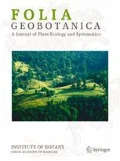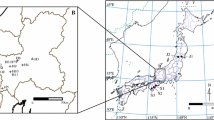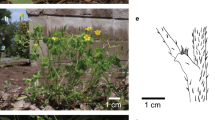Abstract
Rhinanthus minor andRhinanthus angustifolius are known to hybridize in mixed populations in nature. These hybridization events can have important evolutionary consequences. The development and use of species-specific RAPD and ISSR markers allowed the detection of hybrid individuals not always distinguishable with morphological characters. Two mixed populations of different ages were studied. In a young mixed 2-year-old population, both individuals of the two parental species and F1 hybrids were found using genetic analysis, showing that hybridization occurred rapidly. Flower morphology of F1 hybrids was too variable to distinguish all these hybrids from the parental species. This morphological variability of F1 hybrids was also confirmed in artificial crosses in the greenhouse. In an old and no longer mixed 30-year-old population, onlyR. angustifolius plants and a few genetically introgressed individuals close toR. angustifolius were present. Genetic markers showed traces of past hybridization and introgression. Unidirectional introgression ofR. minor intoR. angustifolius with the complete disappearance ofR. minor from this population was observed.
Similar content being viewed by others
References
Arnold M.L. Buckner C.M. &Robinson J.J. (1991): Pollen-mediated introgression and hybrid speciation in Louisiana irises.Proc. Natl. Acad. Sci. USA 88: 1398–1402.
Arnold M.L. (1997):Natural hybridization and evolution. Oxford University Press, New York.
Awasthi A.K., Nagaraja G.M., Naik G.V., Kanginakudru S., Thangavelu K. &Nagaraju J. (2004): Genetic diversity and relationships in mulberry (genusMorus) as revealed by RAPD and ISSR marker assays.BMC Genetics 5: 1 (Jan 10 2004).
Bacilieri R., Ducousso A., Petit R.J. &Kremer A. (1996): Mating system and asymmetric hybridization in a mixed stand of European oaks.Evolution 50: 900–908.
Bucci G., Anzidei M., Madaghiele A. &Vendramin G.G. (1998): Detection of haplotypic variation and natural hybridization inHalepensis-complex pine species using chloroplast single sequence repeat (SSR) markers.Molec. Ecol. 7: 1633–1643.
Campion-Bourget F. (1980): L’hybridation interspécifique expérimentale chez cinq principales especes deRhinanthus L. de France.Rev. Cytol. Biol. Vég. Botaniste 3: 221–280.
Caraway V., Carr G.D. &Morden C.W. (2001): Assessment of hybridization and introgression in lava-colonizing hawaiianDubautia (Asteraceae: Madiinae) using RAPD markers.Amer. J. Bot. 88: 1688–1694.
Carney S.H., Gardner K.A. &Rieseberg L.H. (2000): Evolutionary changes over the fifty-year history of a hybrid population of sunflowers (Helianthus).Evolution 54: 462–474.
Chabert A. (1899): Etude sur le genreRhinanthus.Bull. Herb. Boissier 7: 512–542.
Doyle J.J. &Doyle J.L. (1990): Isolation of plant DNA from fresh tissue.Focus 12: 13–15.
Floate K.D. (2004): Extent and patterns of hybridization among the three species ofPopulus that constitute the riparian forest of southern Alberta, Canada.Canad. J. Bot. 82: 253–264.
Gonzalez-Rodriguez A., Arias D.M., Valencia S. &Oyama K. (2004): Morphological and RAPD analysis of hybridization betweenQuercus affinis andQ. laurina (Fagaceae), two Mexican red oaks.Amer. J. Bot. 91: 401–409.
Ho K.Y., Yang J.C. &Hsiao J.Y. (2002): An assessment of genetic diversity and documentation of hybridization ofCasuarina grown in Taiwan using RAPD markers.Int. J. Pl. Sci. 163: 831–836.
Keim P., Paige K.N., Whitham T.G. &Lark K.G. (1989): Genetic analysis of an interspecific hybrid swarm ofPopulus: occurrence of unidirectional introgression.Genetics 123: 557–565.
Kuehn M.M., Minor J.E. &White B.N. (1999): An examination of hybridization between the cattail speciesTypha latifolia andTypha angustifolia using random amplified polymorphic DNA and chloroplast DNA markers.Molec. Ecol. 8: 1981–1990.
Kwak M.M. (1978): Pollination, hybridization and ethological isolation ofRhinanthus minor andR. serotinus (Rhinanthoideae: Scrophulariaceae) by bumblebees (Bombus Latr.).Taxon 27: 145–158.
Kwak M.M. (1979a): Effects of bumblebee visits on the seed set ofPedicularis, Rhinanthus andMelampyrum (Scrophulariaceae) in the Netherlands.Acta Bot. Neerl. 28: 177–195.
Kwak M.M. (1979b): Maintenance of species integrity in sympatrically occuringRhinanthus minor andR. serotinus in the Netherlands.Oecologia 41: 1–9.
Kwak M.M. (1980): Artificial and natural hybridization and introgression inRhinanthus (Scrophulariaceae) in relation to bumblebee pollination.Taxon 29: 613–628.
Kwak M.M. (1986): Bumblebees and constancy.Acta Bot. Neerl. 35: 39.
Kwak M.M., Holthuijzen Y.A. &Prins H.H.Th. (1985): A comparison of nectar characteristics of the bumblebee-pollinatedRhinanthus minor andR. serotinus.Oikos 44: 123–126.
Lambinon J., Delvosalle L. &Duvigneaud J. (2004):Flore de la Belgique, du Grand-Duché de Luxembourg, du Nord de la France et des régions voisines (Ptéridophytes et Spermatophytes). Ed. 5. Edition du patrimoine du Jardin botanique national de Belgique, Meise.
Martins M., Tenreiro R. &Oliveira M.M. (2003): Genetic relatedness of Portuguese almond cultivars assessed by RAPD and ISSR markers.Pl. Cell Rep. 22: 71–78.
Nason J.D., Ellstrand N.C. &Arnold M.L. (1992): Patterns of hybridization and introgression in populations of oaks, manzanitas, and irises.Amer. J. Bot. 79: 101–111.
Olmstead R.G., DePamphilis C.W., Wolfe A.D., Young N.D., Elisons W.J. &Reeves P.A. (2001): Distintegration of theScrophulariaceae.Amer. J. Bot. 88: 348–361.
Parker C. &Riches C.R. (1993):Parasitic weeds of the world. CAB international, Wallingford.
Perron M. &Bousquet J. (1997): Natural hybridization between black spruce and red spruce.Molec. Ecol. 6: 725–734.
Pharmawati M., Yan G. &McFarlane I.J. (2004): Application of RAPD and ISSR markers to analyse molecular relationships inGrevillea (Proteaceae).Austral. Syst. Bot. 17: 49–61.
Rhymer J.M. &Simberloff D. (1996): Extinction by hybridization and introgression.Annual Rev. Ecol. Syst. 27: 83–109.
Rieseberg L.H. &Ellstrand N.C. (1993): What can molecular and morphological markers tell us about plant hybridization?Crit. Rev. Pl. Sci. 12: 213–241.
Rieseberg L.H. &Wendel J.F. (1993): Introgression and its consequences in plants. In:Harrison R.G. (eds.),Hybrid zones and the evolutionary process, Oxford University Press, New York, pp. 70–109.
Sale M.M., Protts B.M., West A.K. &Rid J.B. (1996): Molecular differentiation within and betweenEucalyptus risdonii, E. amygdalina and their hybrids using RAPD markers.Austral. J. Bot. 44: 559–569.
Sedgley M., Wirthensohn M.G. &Delaporte K.L. (1996): Interspecific hybridization betweenBanksia hookeriana Meisn. andBanksia prionotes Lindl. (Proteaceae).Int. J. Pl. Sci. 157: 638–643.
Soó R. {Pade} &Webb D.A. (1972):Rhinanthus L. In:Tutin T.G., Heywood V.H., Burges N.A. &Valentine D.H. (eds.),Flora Europaea 3, Diapensiaceaeto Myoporaceae, Cambridge University Press, Cambridge, pp. 276–280.
Sterneck J. von (1901): Monographie der gattungAlectorolophus.Abh. K. K. Zool.-Bot. Ges. Wien 1: 1–150.
ter Borg S.J. (1972):Variability of Rhinanthus serotinus (Schönh.)Oborny in relation to the environment. Ph.D. Thesis, Rijksuniversiteit te Groningen, Groningen.
van der Meijden R. (1990):Heukels’ Flora van Nederland. Ed. 21. Wolters-Noordhoof, Groningen.
van Hulst R., Shipley B. &Thériault A. (1987): Why isRhinanthus minor (Scrophulariaceae) such a good invader?Canad. J. Bot. 65: 2373–2379.
Williams J.G.K., Kubelik A.R., Livak K.J., Rafalski A. &Tingey S.V. (1990): DNA polymorphisms amplified by arbitrary primers are useful as genetic markers.Nucl. Acids Res. 18: 6531–6535.
Young N.D., Steiner K.E. &DePamphilis C.W. (1999): The evolution of parasitism inScrophulariaceae/Orobanchaceae: plastid gene sequences refute an evolutionary transition series.Ann. Missouri Bot. Gard. 86: 876–893.
Zietkiwicz E., Rafalski A. &Labuda D. (1994): Genome fingerprinting by simple sequence repeat (SSR)-anchored polymerase chain-reaction amplification.Genomics 20: 176–183.
Author information
Authors and Affiliations
Rights and permissions
About this article
Cite this article
Ducarme, V., Wesselingh, R.A. Detecting hybridization in mixed populations ofRhinanthus minor andRhinanthus angustifolius . Folia Geobot 40, 151–161 (2005). https://doi.org/10.1007/BF02803231
Received:
Revised:
Accepted:
Issue Date:
DOI: https://doi.org/10.1007/BF02803231




